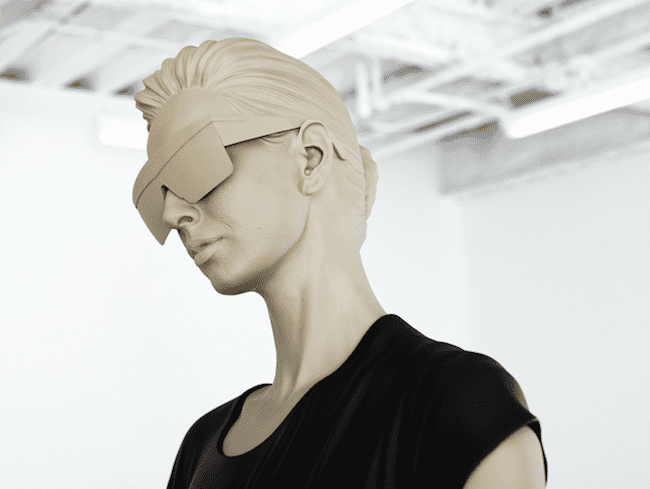CFile started publishing on November 1, 2013. We see the entire 21st century to date to be our period and so, whenever we can, we search back to 2000 for earlier exhibitions, events and debates that are key to putting together a full knowledge of the century. We call these retrospectives “throwbacks,” a term with a subtle ceramic connection.

Frank Benson, Human Statue (Jessie), 2011, Taxter & Spengemann installation view
Frank Benson is and isn’t a ceramist. He has worked with clay twice, but when he makes his bronze sculptures (see above), the patina resembles unfired clay. His art carries the clay sensibility.

Frank Benson, Turtle (Bronze), 2009, bronze, stainless steel and acrylic polyurethane

The two ceramic exhibitions, Extrusions at Artpace (San Antonio November 17,2011 – January 8, 2012 and the next at Andrew Kreps Gallery (New York, September 13-October 27, 2012) were born out of an extruder. Benson goes for minimalism compared to his maximalism. The series started during a residency at Artpace in San Antonio and continued during a subsequent residency at the Chinati Foundation in Marfa, Texas.

Frank Benson, Artpace installation view
Elliot Reichert, no stranger to clay, writes:
“Frank Benson’s Extrusions is an installation of six sculptures and four photographs. Next to the captivatingly vibrant large-scale chromogenic images, undulating sculptural objects atop six light brown plinths are elegant and quiet. Made of brown and black clay, the sculptures hug the generous berth of their wide pedestals, looking like land masses emerging suddenly from the flat, hard earth of a miniature desert.

Frank Benson, Extrusion V (single ribbon hex tube), 2011, ceramic, MDF base
“Although each of Benson’s Extrusions (I-VI) is fired, the sculptural compositions retain a fluidity found in wet clay. Using an extruder—a manual press that transforms a chunk of raw earth into a long, smooth strip—he folded, curled, and tangled clay to create distinctive ribbon-like forms. And, while he has selected only six conformations for display, the edited presentation nonetheless suggests the limitless array of twists and turns that are possible by way of this method.

Frank Benson, Extrusion VI (single ribbon, square tube), 2011, ceramic MDF base
“A distinct rhythm exists in the folded contours of each ribbon. In a single strip of clay, what begins as an even and flat course suddenly folds over itself and takes a sharp, vertical turn before spiraling into a corkscrew, only to bend again as it falls back against the surface of the plinth. Another convoluted ribbon finishes by wrapping around itself to overtake its own tail. On one plinth, two ribbons lie prostrate over one another as if in utter exhaustion. In half of the sculptures, the ribbon is paired with a rigid black rod. Although these beams are also made of extruded clay, they appear to be constructed of an entirely different material. Together, the pairs appear like strips of leather draped over steel rods. In context with the photographs, these couplings of ribbon-like and angled forms echo the softness of the human form next to the hard line of shadow found in architectural detail. Whether they writhe with tension or slink along weakly, the apparent fluidity of the ribbons is a deliberate illusion. Each has been fired in a commercial kiln, rendering the once malleable clay hard, brittle and motionless.

Frank Benson, Extrusion VI (single ribbon, square tube), 2011, ceramic MDF base
“Like Marcel Duchamp, who dropped pieces of string on a canvas and cut out the silhouettes that the fallen threads had arbitrarily defined, Benson allows gravity and chance to help determine the folded configuration of each clay ribbon. In doing so, his sculptures strike an unlikely balance between the planned and the spontaneous, the industrial and the personal.”

I prefer the Kreps exhibition without the clay colored ribbons. It is not that they are unsuccessful, they work visually, but the crisp, minimal black forms by themselves have more power. As the gallery states:

Frank Benson, Extrusion XV, 2012, ceramic formica, sculpture: 19 3/4 x 7 1/4 x 2 1/4 inches; pedestal: 30 7/8 x 20 x 36 1/4 inches

Frank Benson, Extrusion XII, 2012, ceramic and formica, sculpture: 19 1/2 x 7 x 6, pedestal: 31 x 20 x 36 inches
Frank Benson, known for his remarkably detailed life-like sculptures, has, for this body of work, employed a simple tool – an extruder –although the process is simple, the resulting works inhabit a surprisingly wide variety forms while retaining the mechanical imprint of the tool used in their creation. The final fired, but unglazed ceramic sculptures appear to be rendered from mild steel. In these works, Benson achieves a rare formal elegance, accentuating the spontaneous and the arbitrary by allowing the vagaries of the process to inform his decisions about the individual composition of each work.
Garth Clark is the Chief Editor of CFile
Any thoughts about this post? Share yours in the comment box below.

Frank Benson, Extrusion XIII, 2012, ceramic and formica, sculpture: 23 1/2 x 7 x 17 inches, pedestal: 36 x 23 x 36 inches. Click to see a larger image.

Frank Benson, Extrusion IX, 2012, ceramic and formica, sculpture: 23 3/4 x 4 1/4 x 4 inches, pedestal: 38 x 20 x 36 1/4 inches. Click to see a larger image.

Frank Benson, Extrusion X, 2012, ceramic and formica, sculpture: 17 x 4 5/8 x 5 1/4 inches, pedestal: 30 7/8 x 19 x 36 1/4 inches. Click to see a larger image.

Frank Benson

Add your valued opinion to this post.